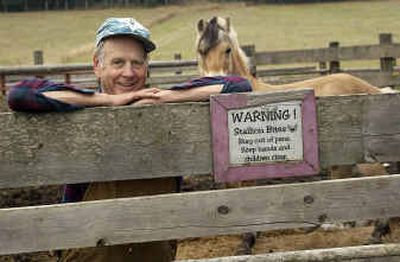Gentle and graceful

Dennis Johnson sends a single, sharp, clear whistle across the meadow that carries into the forest beyond, eight heads come up from their grazing, eight pairs of eyes focus on Johnson. Another whistle and the horses come trotting to line up along the single strand of an electric fence, hopeful of a treat.
All eight are pure-bred, registered Norwegian Fjord horses, (pronounced Fee-ord) and to the casual eye, they are almost identical, standing about 15½ hands tall, sturdy in body, well muscled, yet quick and graceful. The breed can weigh 900 to 1,400 pounds.
The Johnson “Springhill” Fjords, like 90 percent of these horses, are tan-dun in color. The other 10 percent range in shades including blonde, red, gray, yellow or pale dun. All have flowing tails and manes are clipped to stand up like the bristles of a stiff brush. Down the center of each mane, running the length of the neck, is a black stripe of hair, a distinguishing marking of the Fjord horse whose ancestors probably migrated from Central Asia to Norway and were domesticated by about 2000 B.C. Also characteristic are faint stripes on body and legs. Their winter coats are coarse and dense and, according to Johnson, the individual hairs are hollow, providing additional insulation against the harsh winters of their Scandinavian heritage.
Thirty years ago, Dennis and Marge Johnson bought 60 acres of forest and grazing land, an old homestead, on Rimrock Drive north of Hayden. Located in a cozy valley surrounded by gently rolling hills, forest and green pastures, it’s a good place to live, raise a family – and also to raise Fjord horses. The latter was not part of the original plan.
“I thought I would like to breed draft mules,” says Dennis Johnson. But friend and veterinarian, Dr. John Bloxham, talked him into going with him to look at Fjord horses, and there began the Johnsons’ passion for this sturdy, versatile animal with large, gentle eyes. Over the past 20 years the Johnsons have bred and sold more than 70 colts and fillies. Two years ago there were 28 horses in the pastures. Today the couple is down to nine Fjords – one mare, seven geldings and one stallion who is 2 years old. They also are boarding a mare that belongs to their son Devin and his wife, Sonja.
The stallion, Onald , is a new arrival at Springhill Fjords.
“He came from Holland and we had him flown in by air,” saidMarge Johnson. From his private quarters outside the barn, Onald reminds the countryside and local mares of his presence with frequent, determined whinnies. The Johnsons plan to sell him in the spring.
Dennis Johnson, who recently underwent hip surgery, says that they are pretty much getting out of the breeding business because of the work involved but will keep some of the animals for their own enjoyment.
Not only have the Johnsonsbred and raised Fjord horses for the past 20 years but they have been active nationally. “When we began, there weren’t more that 300 Fjords in both the U.S. and Canada, but today there are roughly 8000.”
Dennis Johnson is a past president of the United States Fjord Horse Registry and has served on the board for six years. Marge Johnson is ending 14 years, serving as treasurer of the Pacific Northwest Promotional Group.
The Johnsons are active members of the Sons of Norway lodge and have often entertained fellow members with wagon and sleigh rides at their ranch. “We have been in parades, including the Seattle Seafair parade, watched by 600,000,” said Marge Johnson.
Twice the couple has flown to Norway for what Marge Johnson calls “The Big Stallion Show,” where the stallions are judged for confirmation and performance.
The Johnsons have their own wall full of ribbons won over the years in countless shows – ribbons that are important to those breeding and selling horses. According to the Johnsons, today’s Fjord horses are bred more to become athletes rather than draft horses.
The Johnsons obviously love what they do but they also say that raising colts to adulthood can have its down moments, like the time an unwary animal fell through snow-covered ice in a borrowed pasture and drowned They also lost a filly who was a few months old and developed a lethal lung ailment and died despite heroic efforts to save her. They say this is always hard.
Both sing the praises of the breed, citing the animals’ many abilities and talents.
Fjord horses are strong and some, like draft horses, are used for logging in sensitive areas. Dennis Johnson says that he took one team, just as an experiment, and did some plowing. Fjords also are fine riding horses, are jumpers, and are suitable for dressage, pulling carts and sleighs.They also are great as therapy horses for handicapped or physically challenged children or adults.
Marge Johnson has high praise for the Fjord’s gentle disposition and intelligence – and other people who breed, raise and show them.
“When we go to shows, there are such wonderful people to meet,” she says. “They always give input to each other – what works and doesn’t. They help each other, they give pointers even though they may be competing at shows in the same event. There is no cutthroat competition.
“I guess this is because the people who own them are pretty much like the Fjords themselves – good natured, friendly and willing,” a description that pretty well fits Dennis and Marge Johnson.